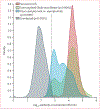Clinical sequelae among individuals with pauci-symptomatic or asymptomatic Ebola virus infection and unrecognised Ebola virus disease in Liberia: a longitudinal cohort study
- PMID: 35588755
- PMCID: PMC9329265
- DOI: 10.1016/S1473-3099(22)00127-X
Clinical sequelae among individuals with pauci-symptomatic or asymptomatic Ebola virus infection and unrecognised Ebola virus disease in Liberia: a longitudinal cohort study
Abstract
Background: Whether or not individuals with pauci-symptomatic or asymptomatic Ebola virus infection and unrecognised Ebola virus disease develop clinical sequelae is unknown. We assessed current symptoms and physical examination findings among individuals with pauci-symptomatic or asymptomatic infection and unrecognised Ebola virus disease compared with Ebola virus disease survivors and uninfected contacts.
Methods: Between June 17, 2015, and June 30, 2017, we studied a cohort of Ebola virus disease survivors and their contacts in Liberia. Surveys, current symptoms and physical examination findings, and serology were used to characterise disease status of reported Ebola virus disease, unrecognised Ebola virus disease, pauci-symptomatic or asymptomatic Ebola virus infection, or no infection. We pre-specified findings known to be differentially prevalent among Ebola virus disease survivors versus their contacts (urinary frequency, headache, fatigue, muscle pain, memory loss, joint pain, neurological findings, chest findings, muscle findings, joint findings, abdominal findings, and uveitis). We estimated the prevalence and incidence of selected clinical findings by disease status.
Findings: Our analytical cohort included 991 reported Ebola virus disease survivors and 2688 close contacts. The median time from acute Ebola virus disease onset to baseline was 317 days (IQR 271-366). Of 222 seropositive contacts, 115 had pauci-symptomatic or asymptomatic Ebola virus infection and 107 had unrecognised Ebola virus disease. At baseline, prevalent findings of joint pain, memory loss, muscle pain, and fatigue were lowest among those with pauci-symptomatic or asymptomatic infection or no infection, higher among contacts with unrecognised Ebola virus disease, and highest in reported survivors of Ebola virus disease. Joint pain was the most prevalent finding, and was reported in 434 (18%) of 2466 individuals with no infection, 14 (12%) of 115 with pauci-symptomatic or asymptomatic infection, 31 (29%) of 107 with unrecognised Ebola virus disease, and 476 (48%) of 991 with reported Ebola virus disease. In adjusted analyses, this pattern remained for joint pain and memory loss. Survivors had an increased odds of joint pain compared with unrecognised Ebola virus disease contacts (adjusted odds ratio [OR] 2·13, 95% CI 1·34-3·39); unrecognised Ebola virus disease contacts had an increased odds of joint pain compared with those with pauci-symptomatic or asymptomatic infection and uninfected contacts (adjusted OR 1·89, 95% CI 1·21-2·97). The adjusted odds of memory loss was more than four-times higher among survivors than among unrecognised Ebola virus disease contacts (adjusted OR 4·47, 95% CI 2·41-8·30) and two-times higher among unrecognised Ebola virus disease contacts than in those with pauci-symptomatic or asymptomatic infection and uninfected contacts (adjusted OR 2·05, 95% CI 1·10-3·84). By 12 months, prevalent findings had decreased in the three infected groups.
Interpretation: Our findings provide evidence of post-Ebola virus disease clinical sequelae among contacts with unrecognised Ebola virus disease but not in people with pauci-symptomatic or asymptomatic Ebola virus infection.
Funding: National Cancer Institute and National Institute of Allergy and Infectious Diseases of the National Institutes of Health.
Copyright © 2022 The Author(s). Published by Elsevier Ltd. This is an Open Access article under the CC BY 4.0 license. Published by Elsevier Ltd.. All rights reserved.
Conflict of interest statement
Declaration of interests We declare no competing interests.
Figures


References
-
- WHO. Health worker Ebola infections in Guinea, Liberia and Sierra Leone: a preliminary report. May 21, 2015. Geneva: World Health Organization, 2015.
-
- Huber C, Finelli L, Stevens W. The economic and social burden of the 2014 Ebola outbreak in west Africa. J Infect Dis 2018; 218 (suppl 5): S698–704. - PubMed
-
- WHO. Ebola situation report December 16, 2015. Dec 16, 2015. http://apps.who.int/iris/bitstream/10665/202501/1/ebolasitrep_16Dec2015_... (accessed June 5, 2016).
-
- Hereth-Hebert E, Bah MO, Etard JF, et al. Ocular complications in survivors of the Ebola outbreak in Guinea. Am J Ophthalmol 2017; 175 (suppl C): 114–21. - PubMed

